#daisy suckley
Text
FDR the Chair Collector
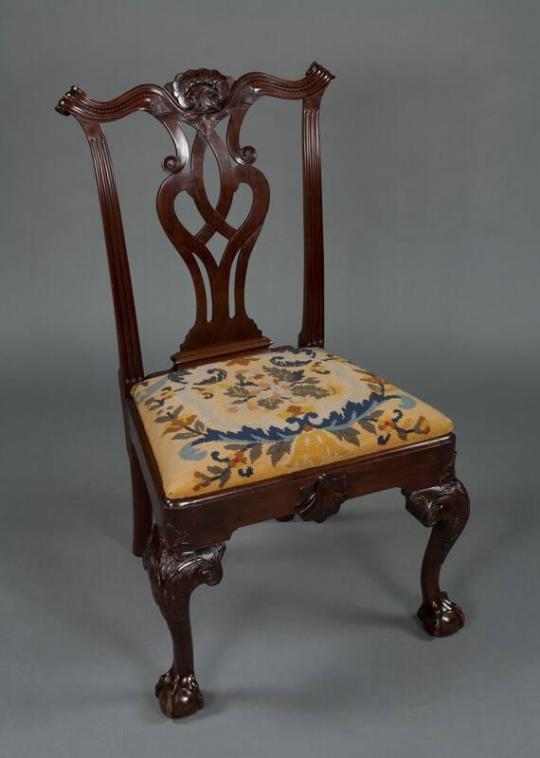
This Chippendale chair once belonged to Benjamin Chew, Chief Justice of the Supreme Court of the Province of Pennsylvania in the 18th century. The chair was lent to Franklin Roosevelt in 1941 by his distant cousin, Margaret L. Suckley, a Chew descendent, who later donated it to the Roosevelt Library. Suckley assisted the President with the furnishing of his Study.
Learn more about this chair on our Digital Artifact Collection: https://fdr.artifacts.archives.gov/objects/29677
Join us throughout 2023 as we present #FDRtheCollector, featuring artifacts personally collected, purchased, or retained by Franklin Roosevelt, all from our Digital Artifact Collection.

#fdr#franklin d. roosevelt#daisy suckley#Benjamin chew#american history#museum from home#artifact collection
8 notes
·
View notes
Text
アルバム DAMAGED PRESENTS CHARGEDをリリース。

BBC RADIO 1の番組「In New DJs We Trust」でホストを務める実力派トランスDJ、JORDAN SUCKLEYが2018年幕開けを飾るNEW MIX CDをドロップ!
UKリバプール出身で、DJとしてこれまでにELECTRIC DAISY CARNIVAL、GLOBAL GATHERING、CREAMFIELDSなどビッグフェスに出演を果たし、プロデューサーとしてもARMIN VAN BUUREN、TIESTO、PAUL VAN DYK、PAUL OAKENFOLDら超大物のリミックスを手掛けてきたJORDAN SUCKLEYが、久々にMIX CDをリリース!
今回はイスラエルの人気急上昇中のデュオCOM!NG SOON!!!を迎えた2枚組仕様で、これぞトランスと唸ること請け合いの高揚感漲るエネルギッシュなシンセが爆発するドラマチック・チューンをメインに、ダークなサイケトランスやアラビア風の旋律が印象的なオリエンタル・チューンまで、最後まで飽きさせないバラエティーに富んだ好内容! 1年のスタートダッシュにぴったりの勢い溢れるMIXです!
HP Source の Synapse をリリースしました。
youtube
Mark Norman Phantom Manor のIndecent Noise をリリース。
youtube
Coming Soon の Trippin’ in Paris をリリースしました。
youtube
0 notes
Text
#NetGalley #ARCReview First Friends: The Powerful, Unsung (And Unelected) People Who Shaped Our Presidents by Gary Ginsburg
#NetGalley #ARCReview First Friends: The Powerful, Unsung (And Unelected) People Who Shaped Our Presidents by Gary Ginsburg #BillClinton #ThomasJefferson #JFK #JohnFKennedy #HarryTruman #AbrahamLincoln #NathanialHawthorne #USPresidents #FirstFriends
Presidents face tons of pressure every day they are in office. Who do they rely upon, outside of their senior advisors and cabinet members, to help them get through the days? Their best friends, who are almost never in the aforementioned groups. But how much is known about these men? Not much until now. First Friends: The Powerful, Unsung (And Unelected) People Who Shaped Our Presidents (Amazon)…
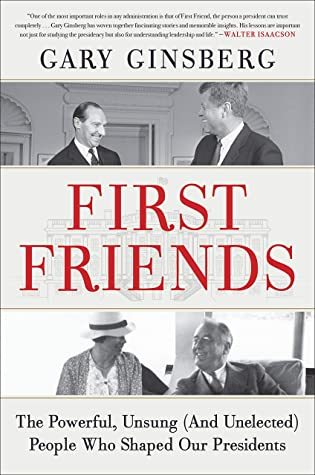
View On WordPress
#Abraham Lincoln#Bill Clinton#Daisy Suckley#First Friends#Franklin Delano Roosevelt#Franklin Pierce#Franklin Roosevelt#Gary Ginsburg#Harry Truman#Hillary Clinton#James Madison#JFK#John F. Kennedy#Nathanial Hawthorne#Presidential History#Richard Nixon#Thomas Jefferson#U.S. History#U.S. Politics#U.S. Presidents#Vernon Jordan
2 notes
·
View notes
Text
Margaret “Daisy” Suckley
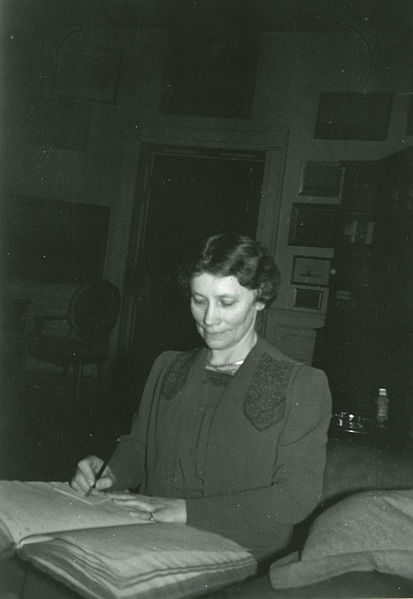
President Roosevelt himself took this photograph of Daisy Suckley in the White House as she went through various papers, February 10, 1942. (Photo: FDR Presidential Library & Museum)
This post was written by Keith Muchowski, an Instruction/Reference Librarian at New York City College of Technology (CUNY) in Brooklyn, New York. He blogs at thestrawfoot.com.
Margaret Suckley was an archivist at the Franklin D. Roosevelt Presidential Library in Hyde Park, New York from 1941 to 1963. But she was much more than that.
“Daisy” Suckley, as she was known to friends and family, was born in Rhinebeck, New York in 1891 and grew up on Wilderstein, the family estate on the Hudson River not far from the Roosevelts’ own Springwood in Hyde Park. This was a small, rarefied world and in the ensuing decades Daisy saw sixth cousin Franklin’s rise to prominence. She eventually became one of his closest friends and confidants, sharing the good times and the bad with the country’s only four-term president. Ms. Suckley was there for Franklin in the 1920s when he was struck paralyzed from the waist down with polio, knew him during his years in Albany when he was New York governor and he became a national figure, attended the presidential inaugural in 1933 in the depths of the Great Depression, offered a discreet and comforting ear during the dark days of the Second World War when, as commander-in-chief, he made difficult and lonely decisions affecting the lives of millions around the world. Finally, Daisy was one of the inner circle present in Warm Springs, Georgia when the president died in April 1945. Roosevelt was inscrutable to most—some called him The Sphinx—but if anyone outside his immediate family knew him, it was Margaret “Daisy” Suckley.

Ms. Suckley (left) in Roosevelt's private office at the presidential library with actress Evelyn Keyes, and Library Director Fred Shipman. Ms. Keyes is holding the album-version of Ms. Suckley's book The True Story of Fala, October 31, 1946. (Photo: FDR Presidential Library & Museum)
There were perks to being Roosevelt’s close friend. The two enjoyed picnics and country drives. Both loved to dish the gossip about Washington politicos and the Hudson River Valley families they had known for decades. Daisy helped President Roosevelt design his Hyde Park retreat, Top Cottage. She enjoyed the “Children’s Hour” afternoon breaks when Roosevelt would mix cocktails for himself and his friends to unwind. There were getaways at Shangri-La, the rustic presidential retreat in Maryland’s Catoctin Mountains known today as Camp David. She attended services at Hyde Park Church with the First Family, King George VI and Queen Elizabeth when the royals visited in 1939. It was she who gave him Fala, the Scottish Terrier to whom he was so attached after receiving the pooch as a Christmas gift in 1941.
President Franklin Delano Roosevelt stood at a podium on the grounds of his family home in Hyde Park and dedicated the Franklin D. Roosevelt Presidential Library on June 30, 1941. He was still in office at the time, having won re-election to an unprecedented third (and eventually fourth) term seven months previously. Roosevelt clearly believed that libraries and archives were themselves exercises in democracy in these years when fascism was spreading around the world. Ever the optimist even as World War Two raged in Europe and the Pacific, Roosevelt declared “It seems to me that the dedication of a library is in itself an act of faith. To bring together the records of the past and to house them in buildings where they will be preserved for the use of men and women in the future, a Nation must believe in three things. It must believe in the past. It must believe in the future. It must, above all, believe in the capacity of its own people so to learn from the past that they can gain in judgment in creating their own future.” Then he quipped to the two thousand gathered about this being their one chance to see the place for free.
Roosevelt had been an unrepentant collector since his earliest boyhood days, with wide-ranging interests especially in naval history, models ships, taxidermy, philately, books on local history, political ephemera, and—probably above all—anything related to the Roosevelt clan itself. His eight-years-and-counting administration had already produced reams of material via the myriad alphabet soup New Deal agencies that had put millions of Americans to work during the Great Depression. It was becoming increasingly obvious in that Summer of 1941 that the United States would likely become entangled in the Second World War; as Roosevelt well understood, that would mean even more documents for the historical record.
Presidential repositories of various incarnations were not entirely new. George Washington had taken his papers with him back to Mount Vernon after his administration for organization. Rutherford B. Hayes, Herbert Hoover, and even Warren G. Harding had versions of them. Nora E. Cordingley (featured in a March 2018 Women of Library History post) was a librarian at Roosevelt House, essentially a de facto presidential library opened in 1923 at Theodore Roosevelt’s birthplace on Manhattan’s East 20th Street whose papers and other materials eventually moved to Harvard University’s Houghton and Widener Libraries. What was new about Franklin Roosevelt’s creation was its codification of what is today’s presidential library system. Roosevelt convened a committee of professional historians for advice and consultation, raised the private funds necessary to build the library and museum, urged Congress to pass the enabling legislation, involved leading archive and library authorities, and ultimately deeded the site to the American people via the National Archives, which itself he had signed into being in 1934.
The academic advisors, archivists, and library professionals at the Franklin D. Roosevelt Library were all important, indeed crucial, to the professionalization and growth of both the Roosevelt site and what would become the National Archives and Records Administration’s Office of Presidential Libraries. However, Roosevelt understood in those early that he also needed someone within his museum and library who knew him deeply and understood the nuances of his life and long career. That is why he turned to Ms. Suckley, securing her a position as junior archivist in September 1941 just months after the opening. The library was very much a working place for the president, who kept an office there, where—unbeknownst to museum-goers on the other side of the wall—he might be going through papers with Daisy, entertaining dignitaries while she looked on, or even making decisions of consequence to the war. Ms. Suckley worked conscientiously, even lovingly, in the presidential library, going through boxes of photographs and identifying individuals, providing dates and place names that only she would know, filling in gaps in the historical record, sorting papers, and serving in ways only an intimate could. The work only expanded after President Roosevelt died and associates like Felix Frankfurter and others donated all or some of their own papers. The work also became more institutionalized and codified. Other Roosevelt aides took on increasingly important roles after the president’s death in 1945. More series of papers became available to scholars in the 1950s and 60s as the Roosevelt Era receded from current events into history. Through it all Daisy Suckley continued on for nearly two more decades until her retirement in 1963.
Margaret “Daisy” Suckley lived for twenty-eight more years after her retirement, turning her attention to the preservation of her ancestral home there on the Hudson but never forgetting Franklin. In those later years when reporters, historians, and the just plain curious curious showed up at Wilderstein and inevitably asked if there was any more to tell about her friendship with Franklin Roosevelt she always gave a wry smile and demure “No, of course there isn’t.” After her death at the age of ninety-nine in June 1991 however a trove of letters and diaries was found in an old suitcase hidden under her bed there at Wilderstein. A leading Roosevelt scholar edited and published a significant portion of the journals and correspondence in 1995 to great public interest. While it is still unclear if there was every any romantic involvement between Franklin and Daisy—as some have speculated for decades—the letters do provide a deeper, more nuanced portrayal of their relationship and show just how close the two were. Franklin Delano Roosevelt may have been The Sphinx to many, hiding his feelings behind a veneer of affability and bonhomie. To his old neighbor, distant cousin, discreet friend, loyal aid, and steadfast curator Margaret Suckley, he showed the truer, more vulnerable side of himself.
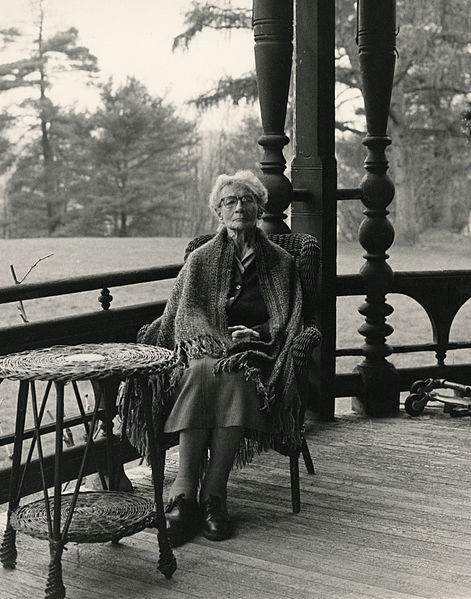
Ms. Suckley later in life at Wilderstein, 1988. (Photo: FDR Presidential Library & Museum)
Further reading:
Hufbauer, Benjamin. “The Roosevelt Presidential Library: A Shift in Commemoration.” American Studies, vol. 42, no. 3, Fall 2001, pp. 173–193.
Koch, Cynthia M. and Lynn A. Bassanese. “Roosevelt and His Library, Parts 1 & 2.” Prologue: Quarterly of the National Archives and Records Administration, vol. 33, no. 2, Summer 2001, Web.
McCoy, Donald R. "The Beginnings of the Franklin D. Roosevelt Library," Prologue: The Journal of the National Archives, vol. 7, no. 3, Fall 1975, pp. 137-150.
Persico, Joseph E. Franklin & Lucy: President Roosevelt, Mrs. Rutherford, and the Other Remarkable Women in His Life. Random House, 2008.
Ward, Geoffrey C. Closest Companion: The Unknown Story of the Intimate Friendship between Franklin Roosevelt and Margaret Suckley. Houghton Mifflin, 1995.
#women's history#library history#tumblarians#daisy suckley#fdr#margaret suckley#archivists#presidential collections#new york history#fdr presidential library#women of library history
12 notes
·
View notes
Text
Unfinished: April 12, 1945
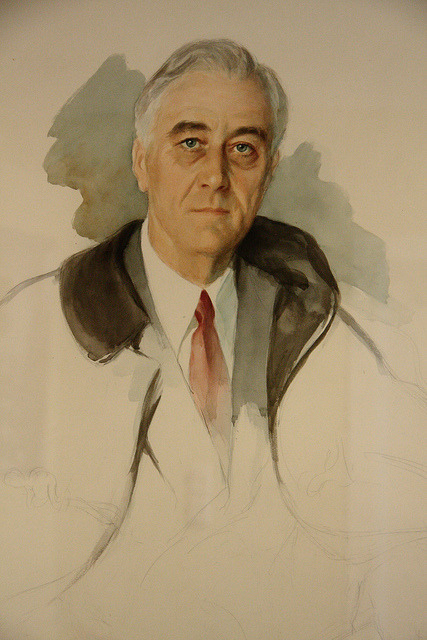
As March 1945 drew to a close, Franklin Delano Roosevelt was exhausted. At the beginning of February, Roosevelt had attended the Yalta Conference with Winston Churchill and Joseph Stalin -- a meeting which required the American President to undertake a physically punishing and extraordinarily dangerous trip halfway around the world to the Crimean Peninsula in the middle of a raging world war. At Yalta, Roosevelt’s appearance had shocked the foreign leaders and their aides. In his last face-to-face meeting with Churchill, on February 18, 1945, FDR was seen as a dead man walking. Churchill’s personal doctor, Lord Moran, told a friend that Roosevelt had “only a few months to live”.
Being President of the United States for just one term is taxing enough on a young man or a healthy man. Franklin Delano Roosevelt had been President for twelve years. He had campaigned for the Presidency and been victorious in four national elections. His Administration faced one of the greatest domestic crises in American History -- the Great Depression -- and the greatest crisis and bloodiest conflict in world history -- World War II. FDR had attacked these problems (and other issues that arose during his terms) with energy, creativity, and a relentless pursuit of victory.
A healthy and athletic man who stood nearly 6′2″ and weighed about 200 lbs. as Assistant Secretary of the Navy under Woodrow Wilson, Franklin Roosevelt had been stricken by polio in 1921. The disease robbed him of his ability to walk and, at the time, looked as if it had robbed him of a political future. He rebounded politically but physically he was never the same. Confined to a wheelchair, the muscles in his legs withered like the branches of a tree in winter. Although he could not walk under his own power, FDR taught himself to stand while wearing heavy steel braces around his shins. He needed the assistance of a muscular partner -- sometimes one of his sons, sometimes a military aide -- in order to feign the appearance of walking. Through sheer will, however, Roosevelt learned to take a few steps without anyone’s help -- a handy skill that he would show off at important campaign rallies. But as he began his unprecedented fourth term in the White House in the early months of 1945, FDR no longer had the energy to show off.
Roosevelt was as gravely ill as Lord Moran suggested. The successful 1944 Presidential campaign had severely drained his already tapped-out reservoirs of energy and stamina. His fourth inauguration was low-key, partly because it took place in the midst of war and partly due to the President’s failing health. Instead of the traditional inaugural ceremonies at the U.S. Capitol, Roosevelt took the Oath of Office at the White House and gave his brief fourth Inaugural Address from a balcony at the Executive Mansion. The famously verbose Roosevelt gave the second-shortest Inaugural Address in American History. By the time the crowd realized that he was talking he had already finished. Only George Washington’s four-sentence-long second Inaugural Address in 1793 was shorter than the address given by FDR on January 20, 1945.
FDR now looked entirely different than the man who had told the nation that “the only thing we have to fear is fear itself” in 1933. Dark circles surrounded his eyes, which seemed sunken into his skull. Since his first Inauguration, Roosevelt had lost 40-50 pounds. His hands shook so violently at times that some observers wondered how he was able to eat. He smoked constantly, but rarely finished his cigarettes. Most shocking of all, FDR no longer went to great lengths to conceal his disability. Frail and tired, he found it almost impossible to wear the heavy braces that he long wore on his crippled legs. On March 1, 1945, Roosevelt addressed a joint session of Congress on the results of his Yalta Conference with Churchill and Stalin. In an unprecedented move, the President sat in a chair on the floor of the House of Representatives and apologized to Congress, beginning his speech by saying, “I hope that you will pardon me for this unusual posture of sitting down during the presentation of what I want to say, but I know that you will realize it makes it a lot easier for me not to have to carry about ten pounds of steel around on the bottom of my legs.” It was the first time that President Roosevelt had ever publicly acknowledged his physical disability.
Twelve years of the Presidency, economic depression and war had strained Roosevelt’s health, but the 14,000-mile trip to the Yalta Conference on the Black Sea had pushed FDR to the limit. On March 30, 1945, Roosevelt arrived in Warm Springs, Georgia for a few weeks of relaxation and, hopefully, recuperation. Roosevelt loved Warm Springs. He had started visiting the small town in western Georgia in the 1920s, hoping that the warm waters from the natural mineral springs nearby would help him regain the use of his legs. When he was Governor of New York, FDR purchased a small house that he used when he visited Warm Springs. As President, the home was called the “Little White House” and although FDR only visited it sixteen times during his Presidency, many of those trips were for 2-3 weeks each. When his train pulled into Warm Springs at about 1:30 PM on March 30, 1945, many longtime residents said that things seemed different. Roosevelt looked terrible and while he waved to onlookers, it was with noticeable weakness.
The first few days in Georgia were tough. FDR was obviously ill and seemed to struggle making it through a church service on Easter Sunday. Roosevelt also avoided his beloved Warm Springs pools. Instead, the President rested, caught up on sleep, and visited with guests. The goal was for FDR to regain enough of his health to make a trip to San Francisco for the charter meeting of what would become the United Nations. At the Little White House with Roosevelt were some personal aides, military attaches, and cousins Daisy Suckley and Polly Delano. During his first week at Warm Springs, Roosevelt did very little work, dictating a few letters and reading briefings, stronger and more animated in the mornings and evenings but completely drained in the afternoon. Another goal for Roosevelt was to gain weight -- by the time he left Warm Springs, he hoped to be up to 170 lbs.
Still, there was no noticeable improvement in FDR’s health or spirits. Then, on April 9th, Lucy Mercer Rutherfurd arrived. As President Wilson’s Assistant Secretary of the Navy, Franklin D. Roosevelt had become involved in a passionate love affair with his wife’s social secretary, Lucy Mercer. It was 1918 when Eleanor Roosevelt discovered the affair between Franklin and Lucy and threatened to divorce him unless he promised never to see or speak to Lucy again. FDR agreed to the ultimatum -- an ultimatum that was strengthened by his mother’s threat to cut off his inheritance if he and Eleanor were divorced, as well as the fact that Franklin’s budding political career would be crushed if the affair was revealed. The relationship between FDR and Eleanor was never again passionate or loving after the discovery of the affair, but Eleanor kept her word and remained married to Franklin. Franklin, however, didn’t keep his word to Eleanor.
The Franklin-Lucy affair probably resumed shortly after Roosevelt’s first Inauguration in 1933. By that time, FDR and Eleanor had more of a professional relationship than a personal one. He respected the First Lady’s political viewpoints, supported her activism, used her as a sounding board, and tried to act on many of her suggestions. Personally, however, there was no passion or tenderness or intimacy between the First Couple. It was FDR and Eleanor’s daughter, Anna, who helped rekindle Franklin’s relationship with Lucy. She arranged for Lucy to visit the President in the White House when Eleanor was out of town. And on April 9, 1945, Lucy Mercer Rutherfurd was in Warm Springs, Georgia visiting President Roosevelt due to Anna Roosevelt’s invitation.
FDR was so excited to see Lucy that he didn’t wait for Lucy to make the drive all the way from Aiken, South Carolina to Warm Springs. The President and his cousin Daisy decided to meet Lucy’s car en route. At Manchester, Georgia, 85 miles away from Warm Springs, the highway rendezvous took place. FDR looked happier than he had in months as Lucy got into FDR’s car along with her friend, painter Elizabeth Shoumatoff. Lucy had brought Shoumatoff along to paint a portrait of the President -- a portrait that she hoped would be an improvement on the recent photographs that had made Roosevelt look “ghastly”.
For the next two days, Roosevelt and Lucy enjoyed their time together, going on small drives, eating happy meals, and sitting together while Shoumatoff prepared to paint the President’s portrait, studying photographs and making preliminary drawings. Daisy Suckley had the opportunity to observe the unique relationship between FDR and Lucy Mercer and also had some private conversations with the President’s longtime mistress. In her diary, Daisy recorded her thoughts about the two after she accompanied them on an automobile drive that they took: “Lucy is so sweet with F(ranklin) -- No wonder he loves to have her around -- Toward the end of the drive, it began to be chilly and she put her sweater over his knees -- I can imagine just how she took care of her husband -- She would think of little things which make so much difference to a semi-invalid, or even a person who is just tired, like F(ranklin).”
On April 12th, President Roosevelt woke up and ate a light breakfast. He had a slight chill despite the warm, humid weather that day and wore his cape draped over his shoulders throughout the early afternoon. Roosevelt did a little bit of work, reading the Atlanta newspapers and dictating some correspondence. Elizabeth Shoumatoff had set up her easel in the living room where the President worked behind a card table that served as his makeshift desk. As Shoumatoff painted, FDR continued reading, and at about 1:00 PM, Roosevelt said, “We have got just about fifteen minutes more to work.”
In the quiet of the room, Daisy Suckley thought that the President had dropped his cigarette and was searching for it because his head slumped forward suddenly. Roosevelt could barely lift his head when Daisy asked what was wrong. He placed his left hand gently against the back of his head and, in a barely audible voice, told Daisy, “I have a terrific pain in the back of my head!”
Roosevelt quickly slipped into unconsciousness as the women in the room summoned help. They called for a doctor who was staying in a cottage close to the Little White House and they helped two of FDR’s valets carry the President into the bedroom. Roosevelt’s hands and feet were ice cold, but he was still breathing. Smelling salts were administered but FDR was unresponsive. As the doctor and aides tried to help the President, Lucy Mercer Rutherfurd and Elizabeth Shoumatoff recognized the hopelessness of the situation. They also recognized the potential scandal that was possible if it was learned that the President collapsed in the presence of his longtime mistress.
Shoumatoff packed up all of her paints and the unfinished portrait she had been working on. Lucy Mercer grabbed her belongings and took one last look at her beloved Franklin. He was still alive when they left, but he was breathing laboriously and his eyes no longer recognized Lucy. Lucy and Elizabeth Shoumatoff had been on the highway back to Aiken, South Carolina for an hour when President Franklin Delano Roosevelt died in Warm Springs at 3:35 PM. The official cause of death was a cerebral hemorrhage. FDR was 63 years old.
Eleanor Roosevelt was notified of her husband’s death a few minutes after 4:00 PM. She summoned Vice President Harry Truman to the White House while he was having a drink at the U.S. Capitol with House Speaker Sam Rayburn. Truman wasn’t told why he needed to hastily come to the White House, but he knew it sounded urgent. As Truman left the Capitol, he ran into a young Congressman who questioned the Vice President about his speedy exit -- a young Congressman named Lyndon Johnson.
At the White House at 5:30 PM, Eleanor Roosevelt broke the news to the Vice President simply a directly: “Harry, the President is dead.” Truman was stunned and asked what he could do for the widowed First Lady. Eleanor smiled sadly and asked, “Is there anything we can do for you? For you are the one in trouble now.” At 7:00 PM, Chief Justice Harlan Fiske Stone administered the Oath of Office to Truman as the 33rd President of the United States.
By that time, Eleanor was on her way to Warm Springs to claim her husband’s body. At about midnight, she arrived at the Little White House in Georgia where she asked about her husband’s last hours. It was then that she learned news almost as shocking as the President’s death. Eleanor found out that FDR had been with his former mistress Lucy Mercer Rutherfurd when he was stricken. She spent 45 minutes alone with his body, picked out the clothing for his burial, but never lost her composure despite the shocks that she experienced that day.
A funeral train returned FDR’s body to Washington, D.C. the next day. Roosevelt was embalmed by morticians who found that the President’s arteries were so hardened that they could barely inject the embalming fluid into his body. FDR’s body laid in state in the East Room of the White House almost 80 years to the day that Abraham Lincoln’s body rested in the very same place following his assassination. On the 80th anniversary of Lincoln’s death -- April 15, 1945 -- Franklin Delano Roosevelt was buried in the garden of his beloved estate Hyde Park on the Hudson River in New York.
Upon his death, the New York Times wrote of the deceased President:
“Men will thank God on their knees a hundred years from now that Franklin D. Roosevelt was in the White House. It was his hand, more than that of any other single man, that built the great coalition of the United Nations. It was his leadership which inspired free men in every part of the world to fight with greater hope and courage. Gone is the fresh and spontaneous interest which this man took, as naturally as he breathed air, in the troubled and the hardships and the disappointments and the hopes of little men and humble people.”
Elizabeth Shoumatoff’s Unfinished Portrait of President Roosevelt -- which she was working on when he died -- now hangs in the Little White House in Warm Springs, Georgia.
#History#Franklin D. Roosevelt#FDR#President Roosevelt#Warm Springs#FDR Library#Death of Franklin D. Roosevelt#Presidents#Elizabeth Shoumatoff
72 notes
·
View notes
Link
One of Franklin Delano Roosevelt's numerous rumored affairs will be revisited in the coming weeks with the release of 'Hyde Park on Hudson,' a film depicting the American president's quasi-incestual affair with his distant cousin, Margaret 'Daisy' Suckley.
The film, opening December 7, stars Bill Murray as Roosevelt and Laura Linney as Miss Suckley.
It takes place during the June 1939 weekend that the British king and queen visited Roosevelt at his upstate New York cottage in Hyde Park, where FDR was said to take a number of mistresses.
3 notes
·
View notes
Text
Top Cottage - Presidential Getaway

Have you ever longer for a place of your own? A home away from home where you can live the way you want to live and get away from it all? If so, than you have something in common with our 32nd President, Franklin Delano Roosevelt. The man who brought this country through a Great Depression and a war certainly deserved a place that he could call his own. After all, what we as residents of The Hudson River Valley all know to be called The Home of FDR was in reality not his home at all but in fact belonged to his mother Sara for 41 years.
The big house on the Hudson that he had always returned to time and again had by 1933 become a mad house full of journalists, advisors, relatives, and of course his ever present mother. His open-door policy which allowed all sorts of people to come to his mother’s home for discussions ranging from the political to the satirical had backfired on him by the mid 30’s and he had grown tired of what he called “the mob.” FDR had been planning for years to build a small getaway on top of Dutchess Hill which was one of the highest points in the county. He had driven to the top many times with daydreams of what he might create there. His cousin Daisy Suckley, who also had a family home on the Hudson, had taken many rides with him in his Ford Phaeton convertible to the top of what they secretly called “our hill” and together they made plans for a cottage.
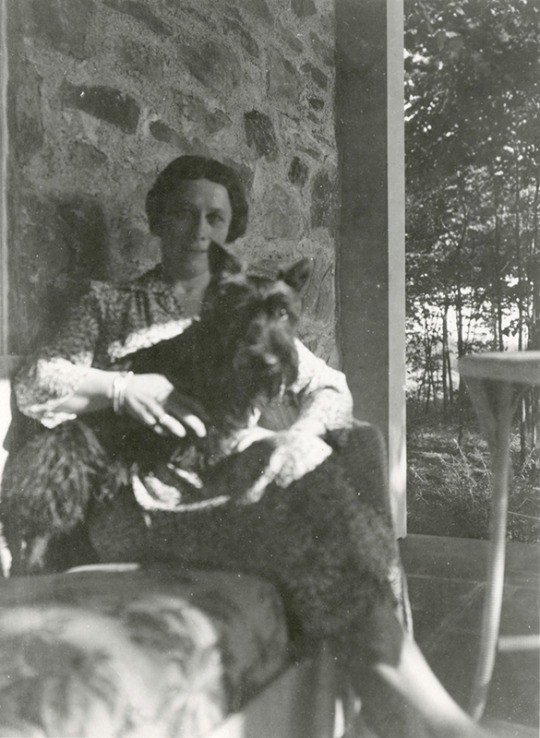
There are only two Presidents who designed and built structures on their estates while serving as President. FDR’s hero Thomas Jefferson had made additions to Monticello and started building Poplar Forest in 1806, and FDR built Top Cottage in 1938. The idea for the cottage was one thing, building it was another. First, the land at the top of the hill did not belong to him, but purchasing land in Hyde Park had never been an issue for FDR and he was able to buy it by 1937 making his family’s holdings well over 1500 acres. Next, came the cost of building which would be rather more than he had expected.
He had planned to build his home for just about $16,000. However it would cost him more than $18,000 which included the contractors, plumbing, plasterwork, furnace, and of course the electric. He tried to save money where he could by using the fieldstone and local materials that were already available on his estate. He also used his own trees as poles for electric lines that ran up the hill from the main road. He used borrowed furniture instead of brand new pieces to fill and make it comfortable. He never had a phone line installed, this might have saved him a few bucks, sure, but he also didn’t want to be disturbed when he was enjoying what we now call “me time.”

The cottage was completed in 1939 and was the first home built by and for a disabled person. Many visitors made their way up the hill with FDR in his sports car including the King and Queen of Great Britain, Prime Minister Winston Churchill, Princess Martha of Norway, Queen Wilhemina and Princess Juliana of the Netherlands. His confidante and cousin Daisy would tag along and listened to him as he “talked mostly about his hopes for future peace,” so would his secretary Missy LeHand. While both women had hopes of sharing the cottage with the President, and Hollywood would like you to think that they did in the Bill Murray film Hyde Park on Hudson, their hopes and a film maker’s fantasy would never come to pass. FDR’s home away from home would never be lived in by him or any of his friends. He died long before he was ready to retire and use the house on a regular basis. When he died in April of 1945, his son Elliott moved in with his wife Faye Emerson. The house was sold by 1952 and it wasn’t until 2001 when it opened to visitors as a National Historic Site.
One must see the cottage to understand how FDR felt about it and how it did give him some kind of peace, be it ever so slight. It is hard to properly express in words how such a lovely little place with intriguing views of the valley could make one feel let alone the President of the United States. But it could be infectious once you journey to the top of the hill and sit on his porch, you may want to go out and follow your dreams of building a home away from home too. You can visit it by shuttle bus from the Henry Wallace Visitor Center in Hyde Park three times a day, May through October. The shuttle bus departs from the visitor center at 11:10, 1:10, and 3:10. Or if you are feeling extra hearty you can hike up the hill from the mile long trail that begins at Val-Kill, Eleanor Roosevelt’s home, and goes up to the top of the hill.

3 notes
·
View notes
Text
All American Tales
After Franklin Roosevelt died on April 12, 1945 in Warm Springs, Georgia of a cerebral hemorrhage, his cousin, Margaret “Daisy” Suckley who was there, took it upon herself to take Fala, FDR’s beloved Scottish Terrier, home with her assuming Eleanor, his absent Missus, wouldn’t want him.
Yes, Fala was a he, named after Murray the Outlaw of Falahill, a famous Scottish ancestor.
Well, Mrs. R. indeed…
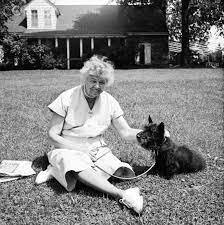
View On WordPress
#Franklin and Eleanor Roosevelt#The Kennedy Years#Theodore Roosevelt White House Years#White House Pets
1 note
·
View note
Text
Hyde Park on Hudson
The story of the love affair between FDR and his distant cousin Margaret “Daisy” Suckley, centered around the weekend in 1939 when the King and Queen of the United Kingdom visited upstate New York.
Trailer film Hyde Park on Hudson
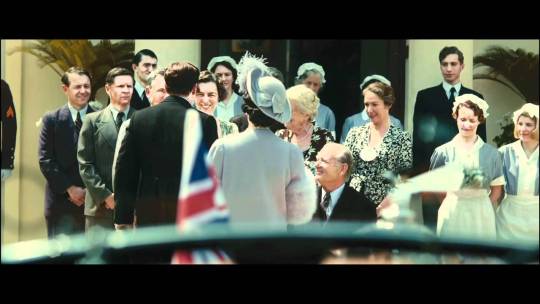
The post Hyde Park on Hudson appeared first on Phim HD online - Kênh xem phim HD online tổng hợp miễn phí trực tuyến.
source https://phimhdonlinez.com/hyde-park-on-hudson/
0 notes
Text
Hunter College Receives Donation of Historic Franklin Delano Roosevelt Correspondence
Hunter College Receives Donation of Historic Franklin Delano Roosevelt Correspondence
Letters between FDR and Daisy Suckley
Will Be on Display for Three Weeks at Roosevelt House
May 8-May 31, 2019
(New York, NY, May 8, 2019) Hunter College announced today its receipt of an invaluable donation of historic correspondence—15 original, handwritten letters from Franklin Delano Roosevelt to his close friend and distant cousin Margaret (Daisy) Suckley that have never before been publicly…
View On WordPress
0 notes
Text
National Dog Day!
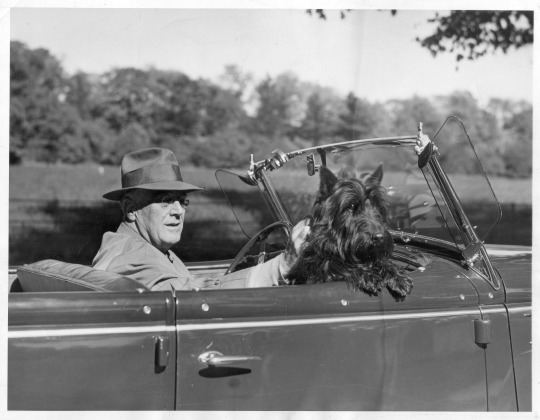
Happy National Dog Day!
Fala was born on April 7, 1940 and given to the President by Mrs. Augustus G. Kellogg of Westport, Connecticut, through Franklin Roosevelt's cousin, Margaret "Daisy" Suckley. At first his name was Big Boy. Franklin renamed him "Murray the Outlaw of Falahill" after a Scottish ancestor. His nickname became Fala. Fala went to live in the White House on November 10, 1940. Every morning Fala had a bone that was brought up on the President's breakfast tray. At night, he slept in a special chair at the foot of the President's bed.
Fala loved to travel with the President on long and short trips by train, car, or boat. In August 1941, Fala was at the Atlantic Charter Conference in Placentia Bay, Newfoundland with the President and Prime Minister Winston Churchill of England. In September of the following year and again in April 1943, Fala went on inspection trips of defense plants and visited the President of Mexico, President Camacho. Later that year in August and then again in September 1944 he accompanied President Roosevelt to the Quebec Conferences. In 1944, Fala was with the President on a sea trip to the Aleutian Islands. Read more about that story on our blog: https://fdr.blogs.archives.gov/2017/10/12/the-adventures-of-fala-first-dog-the-case-of-the-dog-who-didnt-bark-on-the-boat/
While in the White House, Fala was so popular that he received thousands of letters from people and animals from across the country. He had a secretary appointed to him to answer all his fan his mail.
In April of 1945, President Roosevelt died in Warm Springs, Georgia. Fala attended the funeral but seemed lost without his beloved master. He went to live with Mrs. Roosevelt at Val-Kill, where he spent his time running, playing and chasing squirrels and cats. On April 5, 1952, Fala passed away and was buried in the Rose Garden next to the sun dial not far from the graves of President and Mrs. Roosevelt on what would have been his twelfth birthday April 7, 1952.
Continue celebrating #NationalDogDay by exploring some of the Fala related artifacts on our Digital Artifact Collection: https://fdr.artifacts.archives.gov/search/fala
📷: NPx 52-118 - October 22, 1944, Franklin D. Roosevelt with Fala in car at Hyde Park, New York. (UPI photo)
27 notes
·
View notes
Text
Jordan Suckley アルバム Dameged 100 をリリース!

BBC RADIO 1の番組「In New DJs We Trust」でホストを務める実力派トランスDJ、JORDAN SUCKLEYが2019年幕開けを飾るNEW MIX CDをドロップ!
UKリバプール出身で、DJとしてこれまでにELECTRIC DAISY CARNIVAL、GLOBAL GATHERING、CREAMFIELDSなどビッグフェスに出演を果たし、プロデューサーとしてもARMIN VAN BUUREN、TIESTO、PAUL VAN DYK、PAUL OAKENFOLDら超大物のリミックスを手掛けてきたJORDAN SUCKLEYが、久々にMIX CDをリリース! 今回はイスラエルの人気急上昇中Alex Di Stefano を迎えた2枚組仕様で、これぞトランスと唸ること請け合いの高揚感漲るエネルギッシュなシンセが爆発するドラマチック・チューンをメインに、ダークなサイケトランスやアラビア風の旋律が印象的なオリエンタル・チューンまで、最後まで飽きさせないバラエティーに富んだ好内容! 1年のスタートダッシュにぴったりの勢い溢れるMIXです!
Hypnotized のOraw リミックスをリリースしました。
youtube
A-Tronix & Sven E の Technology をリリースしました。
youtube
Vision X Haikal Ahmad の Redemption をリリースしました。
youtube
Supernova をリリースしました。
youtube
Gentech の Feel My Love をリリースしました。
youtube
0 notes
Text
Insomniac Drops Massive EDC Las Vegas 2018 Lineup!
A new post has been published on EDM Life at http://edmlife.com/insomniac-drops-massive-edc-las-vegas-2018-lineup/
Insomniac revealed yesterday the lineup for Electric Daisy Carnical (EDC) 2018 in Las Vegas that includes more than 250 dance music artists from around the globe. The 22nd edition of the annual festival will be held from Friday, May 18th to Sunday, May 20th.
The diverse roster of talent will be playing across eight stages and multiple art cars throughout the Las Vegas Motor Speedway. Fans will experience their favorite artists at stage designs that include kineticFIELD, circuitGROUNDS, neonGARDEN, bassPOD, quantumVALLEY, cosmicMEADOW, wasteLAND, and the Insomniac Records stage. The art cars that will be roaming the 1,000 acre speedway include the Parliament Art Car, Wide Awake Art Car, Bass Wench Art Car, Boombox Art Car, and the Kalliope Art Car.
As EDM Life reported in November, EDC Las Vegas 2018 will feature the inaugural Camp EDC program. The Thursday night kick off party for campers will feature Excision, Habstrakt, and G Jones before the gates officially open. Tickets for EDC Las Vegas 2018 are available here, and checkout the huge lineup below!
EDC Las Vegas 2018 Lineup:
12th Planet b2b Kill The Noise
4B
A-Trak
AC Slater
ADIN
Adrenalize
Adriatique
AFK b2b SVDDEN DEATH
Afrojack
Alan Walker
Alpha 9
Andrew Bayer
Andy C
Angerfist
Animato
AniMe b2b Mad Dog
Arkham Knights
Armin Van Buuren
Astrix
ATB
Atmozfears
Avalon
Big Wild
BIJOU
The Binches
Black Tiger Sex Machine
BlackGummy
Blankface b2b Maze b2b BloodThinnerz b2b Definitive
Blastoyz
Boogie T b2b Squnto
Borgeous
Borgore
Born Dirty
Boys Noize
Brennan Heart
Calyx & Teebee b2b Break
Carmada
Caspa
Charlie
Charlotte de Witte
Cheat Codes
Chris Lake
Chris Lorenzo
Christofi
Cirez D
Claude VonStroke
Code Black
Cold Blue
Conrank
Coone
Cosmic Gate
Crankdat b2b Dirty Audio
Crime Family
Da Tweekaz
Dabin
Darksiderz b2b Mekanikal
Darren Styles
Dash Berlin
Dateless
Datsik
Detlef
Digital Punk
Dimitri Vegas & Like Mike
Diplo
Dirt Monkey
DJ Hype b2b Hazard
DJ Isaac
DJ Mustard
DJ Stephanie b2b Lady Faith
Dombresky
Don Diablo
Dr. Fresch
Dr Phunk
Dr. Rude
DROELOE
Drumsound & Bassline Smith b2b Tantrum Desire
Dubloadz b2b Monxx
Ekali
Elephante
Eptic
Eric Prydz
Excision
Ferry Corsten
Firebeatz vs DubVision
Fisher
Flux Pavilion b2b Doctor P
Fury b2b Fallen
G Jones b2b Eprom
Gabriel & Dresden
Gammer
Ganesh
Genix b2b Sunny Lax
Gentlemen’s Club
Getter
GG Magree
Gorgon City
GRAVEDGR
Green Velvet Presents La La Land
Griffin Stoller
Grum
Gryffin (DJ Set)
GTA
Gud Vibrations
Habstrakt
Hardwell
Headhunterz
HEKLER
Herobust
Honey Soundsystem
Hot Since 82
Ilan Bluestone
Illenium
Ivy Lab
Jace Mek
Jack Beats
Jai Wolf
Jamie Jones Presents Paradise
Jason Ross
Jauz
Jessica Audiffred
John 00 Fleming
John Digweed
Jordan Suckley Presents 3FECT
JOYRYDE
JSTJR
Junkie Kid
K?D
Kaskade
Kayzo
Keiji
Khalid
KITTENS
KSHMR
Kygo
Latmun
Lauren Lane
Lee Foss
Loadstar b2b Mind Vortex
Loco Dice
London On Da Track
Lost Frequencies
LOUDPVCK
Maceo Plex
Mariana BO
Markus Schulz
Marshmello
Martin Garrix
Master of The People
Matt Medved
MC DINO
Melé
Mija
Mike WiLL Made-It
Mister Blaqk
MK
Moksi
NGHTMRE
Nightstalker b2b SOOTHSLAYER
Notorius Two
Oliver Smith
Omair
Ookay (Live)
Parker
Paul Van Dyk
Paul Woolford
Pendulum (DJ Set)
Pulsatorz
R3HAB
Redlight
Rell The Soundbender b2b Rawtek
REZZ
Robotaki
Roger Shah (Live)
Sage Armstrong
Sam Jones
San Holo
SayMyName
Seven Lions
Shiba San
Shimon b2b Benny L
Shmitty b2b No Requests
Sinden b2b LO’99
Slander
SLATIN
Slushii
Snails
SNAVS
Solardo b2b CamelPhat
Space Jesus
spaceprodigi
Spag Heddy
Spencer Brown
Strange Club
Suae
Sub Zero Project
Subset
Tchami x Malaa [No Redemption]
The Pitcher
The Prototypes b2b TC
Tiësto
TNT aka Technoboy ‘N’ Tuneboy
Toneshifterz
Vini Vici
Virtual Self
VOLAC
Warface
Wasted Penguinz
Whethan
Will Clarke
Wongo
XIE
Yellow Claw
Yheti b2b Toadface
YOOKiE
Yultron
Yuuki Yoshiyama
Zedd
Zeds Dead
Zeke Beats
Zomboy
#Bass Wench Art Car#bassPOD#Boombox Art Car#Camp EDC#circuitGROUNDS#EDC Las Vegas 2018#EDC Las Vegas 2018 Lineup#Electric Daisy Carnival Las Vegas 2018#excision#G Jones#Habstrakt#insomniac#Insomniac Records stage#Kalliope Art Car#kineticFIELD#Las Vegas Motor Speedway#neonGARDEN#Parliament Art Car#quantumVALLEY#wasteLAND#Wide Awake art car
0 notes
Text
Hyde Park on Hudson
In 1930s Hudson Valley, Margaret “Daisy” Suckley is reacquainted with her distant cousin, President Franklin D. Roosevelt, to help him relax at his family estate. That aid soon develops into much more as they become lovers. That puts Daisy in a unique position as Roosevelt receives the King and Queen of Britain in 1939 for a visit. As the Royal couple copes with the President’s oddly plebeian arrangements, Daisy learns that there is far more to Roosevelt’s life than she realized. With the world about to be set ablaze by war, friendships are struck and perspectives are gained on that special weekend that would make all the difference with a great, but very human, president.
Hyde Park on Hudson syndicated from http://ift.tt/2rLj3l6
0 notes
Quote
Dear Daisy,
How very strange! But as we have both remarked it is in many ways a queer world -- and really a very nice world in spite of its surface and some of the people who inhabit it -- and it all depends on understanding--
FDR in a letter to Daisy Suckley, 1937
2 notes
·
View notes
Text
Dogs in Hyde Park History
Roger Caras said that “dogs are not our whole life, but they make our lives whole.” Historically, the families of Hyde Park have most certainly agreed with this declaration. Whether it was one of the wealthy “river families” with their pedigree pups or average village families with there cherished mutts, Hyde Park has seen its fair share of dogs. To this day, here in the village, most of my neighbors have dogs who are not just pets, but members of the family. We can see in early photos the appearances of many dogs, posing for the camera along with the rest of the family. I thought I would take a moment to look at some of the historic dogs of Hyde Park.
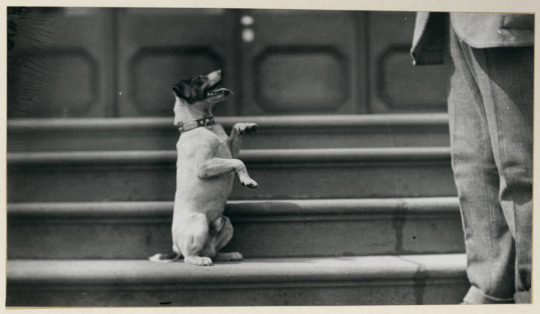
Walter Langdon was the grandson of John Jacob Astor and in 1847 he built a glorious house on the old Bard property in the northern end of town. He lived there with his wife Catharine until his death in 1894. The couple never had any children, but they had at least one dog. Above is a photograph of a small Jack Russell Terrier dancing on the front steps of the Langdon house in Hyde Park. The house was demolished a couple of years after Walter died to make way for the new owners, the Vanderbilts. Frederick and Louise Vanderbilt lived a lavish lifestyle in a mansion filled with Louis the XV styled furnishings, and Italian gardens. They also had many dogs. Sadly, we do not know the history or stories of these dogs, but from the looks of things it is safe to say that they were loved. Here we see Louise with her Jack Russell Terrier, both looking elegant for the camera.

There were local families who worked in town and on the grand estates nearby and they too were proud of their dogs. George Briggs and his family are gathered in this photograph taken around 1892 here in Hyde Park and we see two dogs, a Bulldog and Miniature Pinscher (sitting on the box). We also find the Wicker Family seated on their porch with their terrier posing for the camera. Mr. Wicker worked as a watchman for the Roger’s estate.
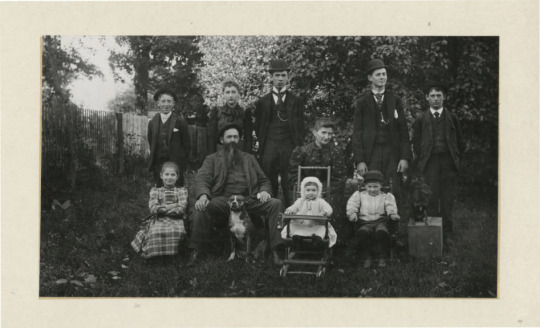
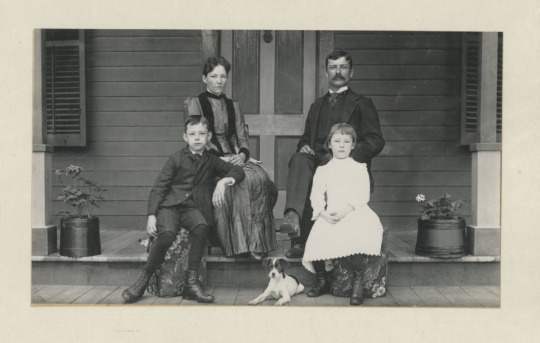
And of all of the families and all of the dogs in Hyde Park, we know the most about the Roosevelts and all of their many dogs. Each of the Roosevelts had dogs that they were connected with and at least two of them are buried in the Rose Garden next to Franklin and Eleanor. As a child, FDR had various dogs to play with. Monk was perhaps his favorite when he was young. His mother Sara had a dog which she brought back and forth from her house in NYC to Hyde Park. His daughter Anna had a German Shepherd named Chief who is buried in the Rose Garden at Hyde Park. When the Roosevelt’s entered the White House in 1933 they brought with them a German Shepherd named Major and Eleanor’s Scottish Terrier Meggie. Both dogs were not well suited for White House life and didn’t stay long.

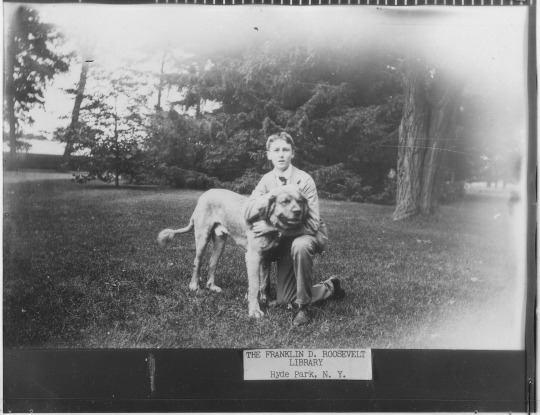

The most famous dog the White House has ever known was of course Fala, the little Scottish Terrier given to FDR as a Christmas present in 1940. His cousin Daisy Suckley gave Fala to FDR but not before she properly trained him to prepare for White House life. His name on his birth certificate says “Big boy” but that was changed to Murray The Outlaw of Fala Hill, and shortened to Fala. FDR insisted that he be the only one to feed his dog, though others would be given the task of walking him. Fala met world leaders, movie stars, and even became a little movie star himself when two short films were made about him starring Pete Smith as the voice of Fala.

Fala’s life was not without its ups and downs as the news clipping below shows that he was nearly killed when Elliott Roosevelt’s dog Blaze, a 135-pound Bull Mastiff, attacked him at Hyde Park in December of 1945. You can see from the article that Eleanor Roosevelt did not like the fact that this story had made its way to the press.
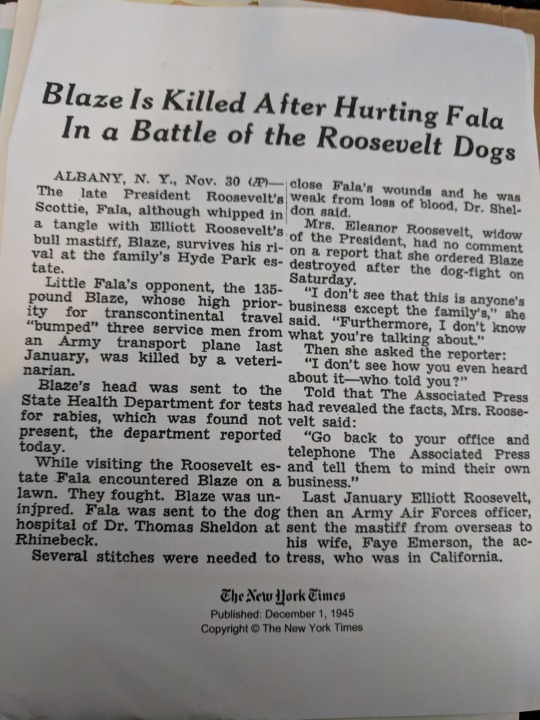
Fala would go on to sire two pups and had several grand-pups as well. Below is a picture of him resting in his bed at Val-kill with his grand-pup Tamas. Both dogs enjoyed running through the woods at Eleanor’s home when she took them out in the morning. Fala died just shy of his 12th birthday in 1952 and had a full obituary in the New York Times.
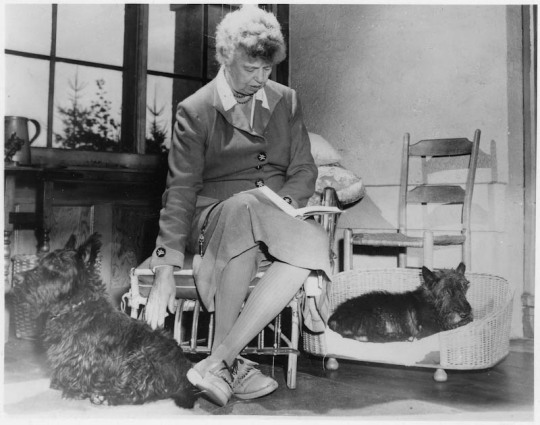
There are many dogs that I am sure I am missing, and I hope if you live in Hyde Park you will share your stories and pictures of your dogs with me! While I was writing this article my dog Mocha (a Miniature Pinscher) watched lovingly from my daybed here in my home office hoping that I might mention him as well. He is very fond of history you know, especially the history of dogs!

2 notes
·
View notes